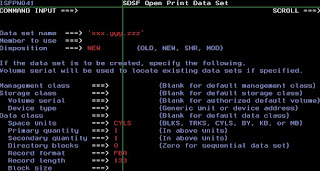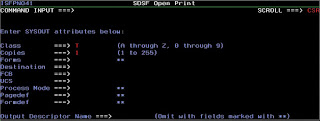
Technical Tips including DB2 z/OS, DB2 LUW, COBOL, JCL, VSAM, CICS, 3rd party vendor tools (BMC, CA, IBM, Macro4, etc.)
Thursday, November 20, 2008
Sample Job: CA/Platinum Fast Unload
Here is a sample job to run CA/Platinum Fast Unload utility:




Labels:
CA,
Computer Associates,
Fast Unload,
Job,
Platinum
Wednesday, November 12, 2008
PRINT job output and SYSLOG from SDSF
Say, you have run a job and you want to save the job output. How do you do it? There are two ways: either you save a softcopy in a dataset or take a print out.
Note: the following methods work only if you have SDSF.
To save job output to a dataset:

To print job output on a mainframe printer:

Sometimes it is required to print the SYSLOG or part of the SYSLOG to a
data set:
Note: the following methods work only if you have SDSF.
To save job output to a dataset:
- Go to SDSF
- Type XDC besides the DDName or the job name
- It will pop up a "SDSF Open Print Data Set" menu.
- Fill in the required fields such as Data set name, Disposition, Space units, Primary Quantity, etc and hit enter. When it is done copying the data to the dataset, you'll get "Print Closed" message on the Top Right corner of the screen.

To print job output on a mainframe printer:
- Go to SDSF
- Type XSC besides the DDName or the job name
- It will pop up a printer menu. Fill in the required fields such as Class, copies and other fields and hit enter. It goes to the held queue(usually)
- Go to the Held queue and release it by typing 'O'

Sometimes it is required to print the SYSLOG or part of the SYSLOG to a
data set:
- To print part of the SYSLOG to a preallocated data set:
- Go to SDSF
- Type the PRINT Command like this: PT ODSN SDSF.PRINT * MOD
- Then type the PRINT command with the date and time for which you need to print the log: PT 06.00.00 10/15/2008 10.00.00 10/15/2008
- Then type this command: PT CLOSE
Thursday, November 6, 2008
Lotus Notes - Save Window State
Well, this is not a mainframe tip. But I use Lotus Notes everyday and today I found something useful that I want to share.
If there are databases or group mail files that you open every day in Lotus Notes, you can setup Lotus Notes to open these on startup.
If Save Window State option is greyed out, click on File, Preferences, User Preferences and check that "Save Window State on Exit" is not checked under "Startup Options".
If there are databases or group mail files that you open every day in Lotus Notes, you can setup Lotus Notes to open these on startup.
- Open all of the windows you want opened every time you open Lotus Notes
- Click on File and select Save Window State
If Save Window State option is greyed out, click on File, Preferences, User Preferences and check that "Save Window State on Exit" is not checked under "Startup Options".
Tuesday, November 4, 2008
APF Authorization
When someone says, "you need to APF authorize this dataset", what do they mean?
Well, APF means "Authorized Program Facility". In a z/OS environment, APF is a facility that permits the identification of programs that are authorized to use restricted functions.
To find the datasets that are APF authorized:
1. Type TSO ISRDDN in your ISPF session (some shops need just ISRDDN with no TSO prefix) and hit enter.
2. Type APF and hit enter. It'll bring up a list of all datasets that are APF authorized.
Remember that, if you like to use a APF authorized dataset in a job STEPLIB, make sure all the datasets in the STEPLIB are APF authorized.
Well, APF means "Authorized Program Facility". In a z/OS environment, APF is a facility that permits the identification of programs that are authorized to use restricted functions.
To find the datasets that are APF authorized:
1. Type TSO ISRDDN in your ISPF session (some shops need just ISRDDN with no TSO prefix) and hit enter.
2. Type APF and hit enter. It'll bring up a list of all datasets that are APF authorized.
Remember that, if you like to use a APF authorized dataset in a job STEPLIB, make sure all the datasets in the STEPLIB are APF authorized.
Monday, November 3, 2008
DB2 SQLCODE=-950
We use BCV split (Business Continuance Volume) technology to clone our Peoplesoft DB2 production subsystem to DB2 test subsystem. After we cloned one of our subsystems, we noticed that our programmers were not able to access QMF. They started getting the error message:
"DSQ16950 The location name is not known to the local DB2 subsystem.".
This was the error message from QMF. The actual error message issued by DB2 was "SQLCODE -950" which means "THE LOCATION NAME SPECIFIED IN THE CONNECT STATEMENT IS INVALID OR NOT LISTED IN THE COMMUNICATIONS DATABASE".
When you get this message check SYSIBM.LOCATIONS to see if a row is there for the DB2 subsystem it is complaining about. If there is one and the values are correct, check the application PLAN. In our case we checked QMF PLAN.
Check if you have the right value for CURRENTSERVER in your BIND PLAN. If you don't have the correct value, rebind the plan with correct value for this parameter. If you are on a local server (on a local LPAR), just remove this parameter. Removing this parameter and rebinding the plan fixed our issue with QMF.
"DSQ16950 The location name is not known to the local DB2 subsystem.".
This was the error message from QMF. The actual error message issued by DB2 was "SQLCODE -950" which means "THE LOCATION NAME SPECIFIED IN THE CONNECT STATEMENT IS INVALID OR NOT LISTED IN THE COMMUNICATIONS DATABASE".
When you get this message check SYSIBM.LOCATIONS to see if a row is there for the DB2 subsystem it is complaining about. If there is one and the values are correct, check the application PLAN. In our case we checked QMF PLAN.
Check if you have the right value for CURRENTSERVER in your BIND PLAN. If you don't have the correct value, rebind the plan with correct value for this parameter. If you are on a local server (on a local LPAR), just remove this parameter. Removing this parameter and rebinding the plan fixed our issue with QMF.
Sunday, November 2, 2008
Platinum Fast Load Error "PFL8013E"
If a Fast Load job fails with PFL8013E (Error Description: A table within Table Space that has multiple versioned rows is not supported for this release of Unicenter Fastload. Reason: This DB2 V8 feature is not yet supported by Unicenter Fast Load. Processing terminates), it could be because the tablespace is in AREO (Advisory Reorg pending) status. This happens in a DB2 V8 NFM subsystem, with Fast Load (version r11.5) Resume NO REPLACE option specified.
How will you fix this? There are a few options that you can try:
1. Run REORG utility on the tablespace and retry loading.
2. If that doesn't work, drop and recreate the table and then load the table using Fast Load
3. If that doesn't work, try IBM LOAD. That should definitely work.
How will you fix this? There are a few options that you can try:
1. Run REORG utility on the tablespace and retry loading.
2. If that doesn't work, drop and recreate the table and then load the table using Fast Load
3. If that doesn't work, try IBM LOAD. That should definitely work.
Subscribe to:
Comments (Atom)